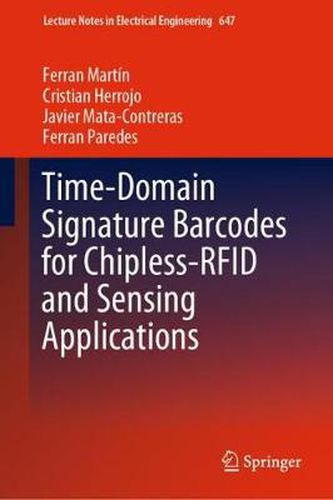Readings Newsletter
Become a Readings Member to make your shopping experience even easier.
Sign in or sign up for free!
You’re not far away from qualifying for FREE standard shipping within Australia
You’ve qualified for FREE standard shipping within Australia
The cart is loading…






This title is printed to order. This book may have been self-published. If so, we cannot guarantee the quality of the content. In the main most books will have gone through the editing process however some may not. We therefore suggest that you be aware of this before ordering this book. If in doubt check either the author or publisher’s details as we are unable to accept any returns unless they are faulty. Please contact us if you have any questions.
This book presents an unconventional approach for implementing chipless radiofrequency identification (RFID) systems and related sensors. Contrary to most state-of-the-art chipless-RFID systems, the proposed approach is based on time domain and the tags are read through near field. The book discusses different aspects of these chipless-RFID systems, including tag and reader design, strategies to enhance the data density and capacity, tag programming and erasing, tag implementation in plastic and paper substrates, and synchronous tag reading, among others. A tolerance analysis and validation of the different systems, as well as prospective applications, are also included. The book also offers a comprehensive overview of the state-of-the-art in chipless-RFID technology, including a comparative analysis, which is extended also to chip-based RFID systems.
Readers are expected to be familiar with RF/microwave engineering technology. Besides master’s and postgraduate students, the book is intended for researchers in the field of radiofrequency identification (RFID) technology, and may be of interest for engineers working in the areas of wireless communications, automatic identification, security, authentication, microwave and wireless sensors, as well as those dealing with internet of things (IoT) and smart systems.
$9.00 standard shipping within Australia
FREE standard shipping within Australia for orders over $100.00
Express & International shipping calculated at checkout
This title is printed to order. This book may have been self-published. If so, we cannot guarantee the quality of the content. In the main most books will have gone through the editing process however some may not. We therefore suggest that you be aware of this before ordering this book. If in doubt check either the author or publisher’s details as we are unable to accept any returns unless they are faulty. Please contact us if you have any questions.
This book presents an unconventional approach for implementing chipless radiofrequency identification (RFID) systems and related sensors. Contrary to most state-of-the-art chipless-RFID systems, the proposed approach is based on time domain and the tags are read through near field. The book discusses different aspects of these chipless-RFID systems, including tag and reader design, strategies to enhance the data density and capacity, tag programming and erasing, tag implementation in plastic and paper substrates, and synchronous tag reading, among others. A tolerance analysis and validation of the different systems, as well as prospective applications, are also included. The book also offers a comprehensive overview of the state-of-the-art in chipless-RFID technology, including a comparative analysis, which is extended also to chip-based RFID systems.
Readers are expected to be familiar with RF/microwave engineering technology. Besides master’s and postgraduate students, the book is intended for researchers in the field of radiofrequency identification (RFID) technology, and may be of interest for engineers working in the areas of wireless communications, automatic identification, security, authentication, microwave and wireless sensors, as well as those dealing with internet of things (IoT) and smart systems.